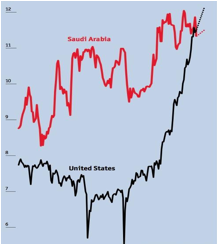Oil Production is in Flux. Gas Supply is Uncertain. Where Are The Safe Investments?
Commentary by S. Tom Bond, Retired Chemistry Professor and Resident Farmer, Lewis County, WV
This graph is supposed to show the American ascendancy in oil production. The result is claimed over and over. Concealed are three important facts:
(1) The gap between the extraction cost in Saudi Arabia’s conventional oil and the US fracked oil is approximately $60/bbl. Extracting oil from shale costs $60 to $100 a barrel, compared with $25 a barrel on average for conventional supplies from the Middle East, according to the International Energy Agency [IEA]. Extreme energy extraction is just that – extremely expensive.
(2) U. S. shale drillers have to deal with high decline of production where redrilling the shales requires constant vast input of capital to keep up high production. They are on the “drilling teadmill.” Quarter by quarter they have to struggle to keep up appearances of profitability to attract capital.
(3) They are already beginning to have to deal with the fact there are “sweet spots” where production is good, but much of the drilling range is not so rewarding. They find the sweet spots in early drilling by spacing wells widely and drilling the second round adjacent to the best of the first round. Get out of the sweet spots and some wells are not even breakeven, although in the targeted shale.
You are sure to know the price of oil is down. As of this writing, $67.39 a barrel. According to the Washington Post, down 40% since mid mid-June (then $115). Oil is a commodity, so it responds to supply and demand. It is notoriously unstable, a gambler’s dream. Storage capacity is small compared to the volume being used, so production has to go somewhere, and the price is reduced to get rid of it.
The fracking industry tells us price is down because of the increasing production of American oil. Too quick and self-serving, it is best to look for more substantial reasons, because we have not reached self sufficiency, and can’t for more than a short burst. Reserve calculations don’t factor in decline in return due to come, because of moving out of the sweet spots.
The decline in the economy world-wide is part of it – less demand. You’ve heard of the disappointment of Black Friday sales – they didn’t get as much as expected. Russia is nearing a recession. Much of Europe has trouble. Japan doesn’t seem able to pull out of recession, and China is slowing. It’s bound to have an effect, along with recent increased production by Libya, Nigeria, South Sudan, Iraq and Russia. Some think the previous high price has induced an increased efficiency of oil use, too.
All cite the decision by Saudi Arabia not to decrease production as a major part of falling prices. World consumption of oil is 85.5 million barrels per day, with Saudi Arabia contributing to it 10. 2 million a day. That’s about one-eighth world consumption. (It could pump 12.5 million, so it is already holding in, while most oil producing countries need money and pump all they can.) As a member of the Organization of Petroleum Exporting Countries (OPEC), the Saudi’s have a controlling interest. U. S. – Saudi relations is much too complicated to get into here, but basically the U. S. is pledged to protect the Saudi family’s hold on Arabia, in return for her control of the oil price for U. S. interests (Saudi Arabia also provides 40% of the U. S. arms production industry income. The U. S. is the largest arms producer in the world, $28B worth.)
The Saudi’s want the U. S. to wipe out Iran, their worst enemy, but Iran produces too much oil, 4.14% of the world supply. Since the U. S. is not complying, the shoe is now on the other foot. It may be that the real reason Saudi Arabia won’t turn down the production is because it is in their national interest. Here’s why.
Two things can be expected to happen if oil stays low:
(1) The other oil producing states will feel the hurt, because they need the money. If this continues for a year or more, they will be compelled to join OPEC, giving the Saudi’s much more power to raise of lower oil prices (which also effects natural gas, too).
(2) Low prices puts the fracking producers in the U. S. and elsewhere in trouble. Many of fracking companies are marginal now, because of the “fracking treadmill,” the necessity having to drill many new wells constantly to maintain production, and because of the high cost of inputs.. They have to seek new capital quarterly. If profits won’t allow repayment, the big banks will surely cut off funds and leave them swinging in the breeze.
These topics will be interesting for a long time to come. Anybody want to invest in shale?

